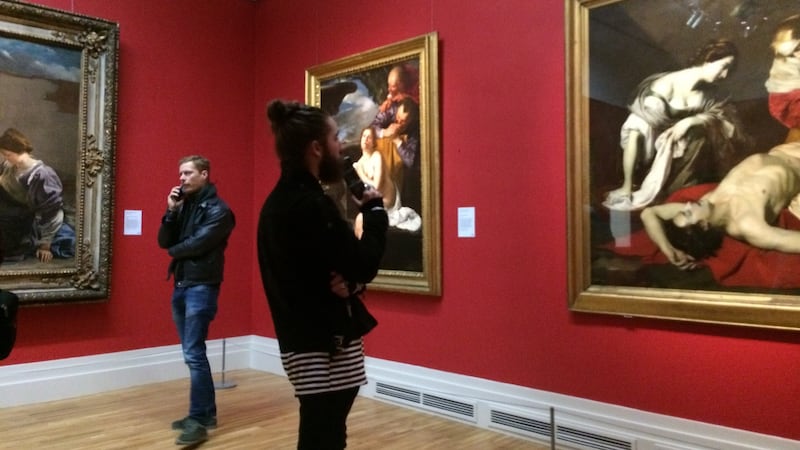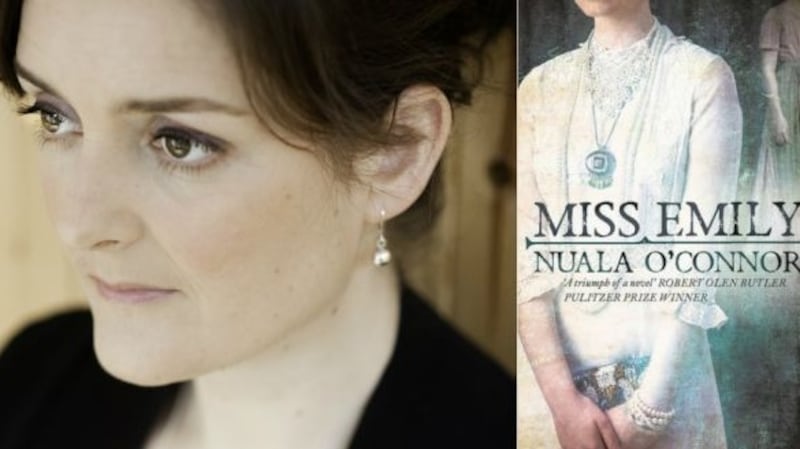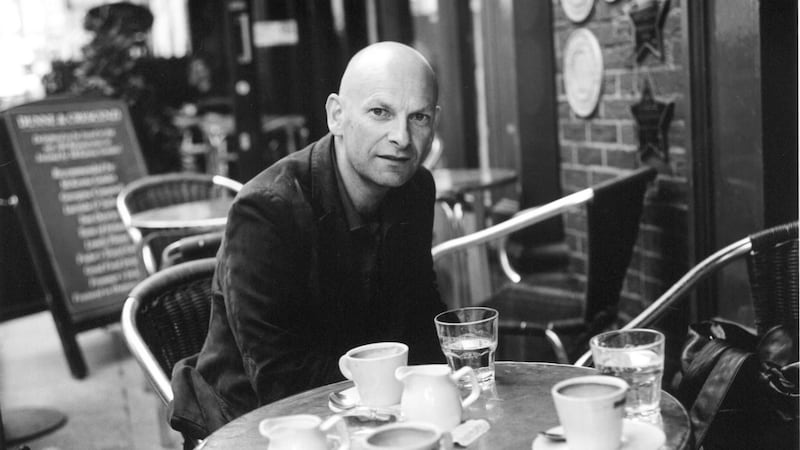“How hard it is,” Scorsese tells art historian Andrew Graham Dixon, “how hard it is-to kill a man who doesn’t want to die.” He’s talking about the famous car-boot scene in Goodfellas. Scorsese says he learned this from Caravaggio, specifically from his painting The Crucifixion of St Peter, in which the disciple is being crucified upside down, tortured and beaten but holding to life. All that Scorsesian light, Dixon tells us, he owes to the so-called bad boy of 17th-century painting – revolutionary, murderer and lover, Michelangelo Merisi da Caravaggio.
Scorsese directed his iconic film 400 years after Caravaggio’s chiaroscuro – his famous light and shade – and his natural style of painting was the talk of Rome. In the early 1600s his paintings were often unveiled to thousands, who crowded to see Caravaggio’s work as much because they hated as loved him. All this time later, I was on my way to see an exhibition in The National Gallery, Beyond Caravaggio, which places his work alongside artists who learned, mirrored and borrowed from him.

0 of 5
Why, my daughter wanted to know, was I taking the train to Dublin to see paintings by a man dead for four centuries? She asked the question with the lack of cynicism an 11-year-old still – just about – has. Why are some artists and writers famous, and how come some things last? She’d asked the same about Shakespeare recently; her class are doing a version of Hamlet at school. Her mouth opened when I finished off the famous soliloquy. I’m not sure what she was more impressed by – the fact I remembered it, or that I learned it twice her lifespan ago. It’s in my hard drive, alongside Sonnet 18, Dulce et Decorum est, and Not Waving but Drowning. Why do some things persist?
The woman at the coffee kiosk at the train station said she’d been to the show. “I didn’t think I’d like it at all but I did,” she said. Her intonation rose in surprise, making me wonder why some people decide they dislike something based on its reputation in exactly the same way as the reverse.
“Go to the exhibition in the Hugh Lane – that one’s free,” someone else told me later. Caravaggio probably would have said something similar. He despised the idea of high art, of exclusivity, the mannerism of Michelangelo (he was named for the saint, not the artist). He didn’t want ordinary people to go into a church and revere his paintings, or to feel intimidated, to look up at those highly stylised archangels and feel they were in the wrong place, that it wasn’t “for the likes of them”. He wanted them to feel at home. This is why, Dixon tells us, he has a horse’s arse prominently featured in The Conversion of Saul. He was of the people, and for the people, and initially didn’t have a patron to please.
Later, when the church courted him, they wanted him in marketing – think Mad Men but with oils. He brought familiar Biblical scenes bang up to date, made them relatable, made the church relevant. Transposed to today, his paintings would have taglines like “what Jesus does next is jaw dropping” and “what St Matthew looks like now is unbelievable”. If he was working for the modern-day equivalent of the Catholic Church, it would be for one of the big corporates or media giants. Or perhaps he’d be a street artist, satirising the rotten core of the church and its horrific crimes, the irony of capitalism, society’s narcissistic eating of itself. I’m guessing his message would still be the same: look, and you will see.
Part of my daughter's question is literature 101. Why is Caravaggio more famous in Ireland than Artemisia Gentileschi? Why are we not as familiar in Europe with Wang Jian or Bada Shanren as we are with Caravaggio? Why Bob Dylan and not Dave van Ronk? How come until recently colleges all had that black and white poster of Irish writers in their classrooms, with the portraits of WB Yeats, Oscar Wilde and Samuel Beckett but not Kate O'Brien, Elizabeth Bowen or Maeve Brennan (redressed by The Irish Times in this poster)?
The canon says as much about a culture and a period by who isn’t included as by who is, and for decades in academia it has been viewed as a fluid, arbitrary database rather than something set in stone. Putting it more succinctly, “fuck with the canon” says comedian and activist Tara Flynn in a recent workshop where she gives tips on production and casting in the 21st century.
History is being rewritten by a slow resurrection of silent voices in all fields, trickling through from scholarly theses to bestselling anthologies like The Long Gaze Back (New Island). Despite how things change, why some people make it and some don’t often boils down to three words – power, power, power: whether that’s wealth, influential friends, patronage or all three, back in Caravaggio’s time or today, it has always been – dispiritingly – about who you know, as much as what you know.

I told my daughter that there was no such thing as an unbiased system where the cream rises to the top. I introduced her to the term meritocracy only to tell her there isn’t one; I was met with a yeah-ok-I-sort-of-knew-that-anyway expression. Maybe this upcoming generation is more familiar with life’s inevitable quid pro quo from social media, where status and popularity are currency; there’s a kind of Black Mirror ratings system, a vocabulary of exchange. Despite PhDs still being written on the subject, explaining that part of the issue was relatively easy compared to the other part of her question, the one which reaches under the seam of it all: what is it about the work that makes it last?
I asked two writers whose work leans into the past, in different ways: Nuala O’Connor and Alan McMonagle. O’Connor’s novel Miss Emily (Penguin) is the story of 19th-century poet Emily Dickinson and her unusual friendship with fictional Irish maid Ada Concannon. O’Connor recreates the time and place of Amherst, Massachusetts with skill and depth, the language and tone of the novel mirror its time and place. It is a world apart, yet it still transfixes, we still connect. Why is it that the words and life of Emily Dickinson, real and fictionalised, can still speak to us? O’Connor says it’s the things which make our hearts beat faster that reach out through time.

“The art that endures has, at its heart, recognisable humanity, I think that’s the crux of it. Those essential human truths are why we can read, say, a 19th-century poem, from the likes of Emily Dickinson, and find comfort in it. The poet knows us, she knows what sets our hearts racing and what makes us sad, and she offers solace across the years with her well-put-together words. Art that endures is truthful and its message bears repeating.”
Caravaggio got to the heart of a story, for those who could see it. Supper at Emmaus shows Jesus (unrecognised as the risen Christ) sitting at a table, sharing a meal with two of his apostles. The moment when Jesus blesses the bread, he is recognised by one of them, whilst the other is still in the dark (literally in shadow): the painting is this instant of recognition, of miracle.
In the exhibition room, it was surrounded by a handful of people, looking for something in the painting, some meaning or revelation. Some resembled the disciple in the dark, their faces said: what’s all the fuss about? Others were searching for details, moving in and out from the canvas as they listened to the facts about the piece. One woman’s mouth turned up at the edges, her cheek pressed to the audio guide like she was stifling tears; her face was saying “oh my God, it’s Caravaggio” in much the same way as the apostle in the picture is saying – Jesus Christ!
Look carefully at the picture and there are all sorts of messages. The nearest person to Jesus is the one in the worst clothes, the dirtiest, the poorest: Caravaggio tells us that you will always be closer to God if you’re poor. The fruit in the basket teetering on the table has apples and grapes which speak both of the fall in Eden, and the blood of redemption. The more you look, the more you see.
I wonder about these stories, these myths which contain truths, morals, philosophy, and how my daughter doesn’t know an evil apple from the eye of a needle; she doesn’t know what an apostle is, and her knowledge of the crucifixion is vague. So when I showed her The Taking of Christ, without explaining the background, it had none of its power: Judas, the kiss, betrayal, the word Gethsemane – without the story, they meant nothing. She is already building a different metaphorical database. I wonder how those paintings will change in our consciousness, once the story is another 400 years old.
Artemisia Gentileschi must have known Caravaggio – her father was friends with him during her childhood – and you can see his influence in her natural style and use of light. She borrowed his composition for Judith Slaying Holofernes, but she made it acutely hers. In the picture, she paints herself as Judith, and the man she is decapitating – expertly, with vigour – is the man who raped her, Agostino Tassi. The painting thrills because it is real. The anger, revenge and triumph of it rings true.
But the chosen painting for the show is the less bloody but equally powerful Susanna and the Elders. Here Gentileschi updates the Old Testament story in which two men try to seduce the bathing Susanna. In her work, the men are leering, lascivious, pathetic even – but still a danger; Susanna is desperately trying to cover her naked body. She paints Susanna in a typical Venus pose but contrasts this classical image with a woman who is real – not as male artists of the time wanted to see and portray women, not in a classical ideal of beauty and not to please an erotic gaze. Here am I and here are women like me, she says, and I’m putting us in the picture – a few hundred years before pioneering feminists questioned the male gaze. In Susanna, she shows us how it feels to be objectified, to be unsafe, to be vulnerable – but it is also a glorious up yours to the patriarchy. Some things change, and some things stay the same.
Gentileschi learned from Caravaggio how to paint a story – not just the overt one, but the one buried in its heart. And the story, says Alan McMonagle, is what matters. McMonagle’s extraordinary debut novel Ithaca (Picador) takes its name from a Greek legend written in the eighth century by Homer, an author we may never know much about. What survives is the story. Whether it’s the Odyssey or The Taking of Christ, McMonagle says, this is what matters. The Greek myths which inspired McMonagle’s childhood imagination are also the source for his novel, set in post-boom Ireland. In his dark, funny and dazzling story, his young protagonists invent adventures for themselves, from ancient Egypt to the search for Ithaca.

“When it comes down to it,” McMonagle says, “there are two stories to tell: a person goes in search of something and a stranger comes to town. The remark has been attributed to, amongst others, Dostoyevsky, Tolstoy, and more recently to the American novelist John Gardner. The great Jorge Luis Borges (referencing Homer and the Bible) writes as much in his amazing story The Gospel According To Mark. The wonderfully dark American short story writer Flannery O’Connor went a little further. She reckoned that although there may only be a certain number of stories to tell, there is always a new way to tell them.
“Two short story collections, one radio play and a debut novel into my own writing adventure and it feels to me that every time I embark on a story I am asking my narrator four questions. Who am I? Where do I come from? What do I want? And how am I going to get it? The first two questions I feel pertain to ‘the stranger’ myth. The latter two to ‘the search’. Time passes. Society changes. People acquire new habits, develop new technologies and medicines, persist with killing each other – and usually because they are either looking for something (the search) or because they are afraid of something or someone (the stranger). The essential doesn’t change – so says Samuel Beckett, and I am inclined to agree.”

I stayed in the exhibition space for a long time, thinking about that – about how some things change, and some things remain. I watched the people come and go. When I finally left, I’d like to say that the light was falling in chiaroscuro on the street outside, but it wasn’t. It was raining and people were marching to Pearse Street train station. On my way there I saw a couple kissing under an umbrella in another world, someone begging, a plastic bag for protection, two people high, arguing, and everywhere faces, faces, faces, each worth illuminating, each one a story.
Recently, writers spoke of love stories they have returned to, in good times and bad. Fintan O'Toole quotes Shakespeare's Sonnet 154, in which love cannot be extinguished. Maybe art which persists – in all its forms – is like that; it contains that indefinable something that refuses to die, just like Scorsese's man in the boot, like Caravaggio's Peter on the cross: it reveals a truth about being human through the story it tells, in pain or ecstasy, darkness or light. As the saying goes, we are all stories, in the end.
Ruth McKee is a writer and editor of spontaneity.org
Beyond Caravaggio runs until May 14th at the National Gallery, Dublin























